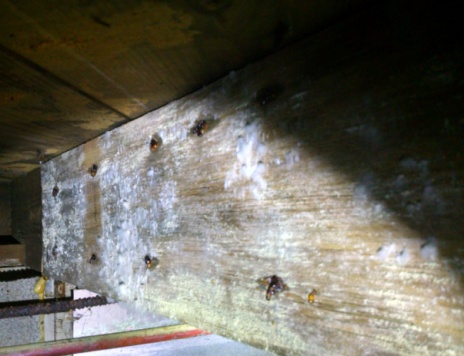Find a Mold Specialist Now
Click or Call, Toll-Free 24/7
Indoor Sistotrema Mold
Sistotrema is a common type of mold and is frequently found in buildings on wet or decaying wood surfaces, especially along cracks in the wood. It is often found growing around doors and windows, although it can be found in other places, as well. It is sometimes found on fabric, as well, like carpet, damp clothing, mattresses, or upholstered furniture.
It is white in color and feels waxy to the touch. Under a microscope, you can see what look like rows of tiny white knots, but these are not visible to the naked eye.
Is It Sistotrema?
While white-colored mold is less common than black, gray, or even brown mold, this is certainly not the only strain of mold that is white in color. You cannot determine what kind of mold is growing in your home by its appearance, color, or where in the home it is growing.
If you want to now what kind of mold it is, you can have the mold tested. The Centers for Disease Control and Prevention (CDC) says that in most cases, you don't really need to know what kind of mold is in your home. It doesn't really matter because all types of mold are potentially harmful – they can all damage your home and they can all cause illness – so the mold, whatever kind of mold it is, needs to be removed as soon as possible. You can read more about how mold damages homes and about mold-related health problems by following the links.
While it may not be necessary to know what kind of mold you have in your home, you might opt to have your home tested for mold if you're not sure if there is mold in your home or not. The U.S. Environmental Protection Agency also suggests having your home tested for mold if you've had mold removed, in order to make sure the job was done thoroughly. You can read more about mold testing here. And if you're interested in having your home tested for mold, you can follow this link to find a list of qualified mold testing professionals in your area.
 Sistotrema Mold
Sistotrema MoldRemoving Sistotrema from Your Home
It's important to remove mold from your home as soon as possible. Mold spreads easily and it doesn't take long for mold to spread from one area of the home throughout the entire house. To prevent extensive, not to mention costly, damage to your home, it's important to act fast.
Of course, it's also important to act fast in order to protect your health and the health of your family. The longer you're exposed to mold, and the greater the amount of mold in your home, the greater your risk for mold-related health problems, which can be serious in some cases.
Some homeowners prefer to handle the mold removal themselves, while others prefer to hire a professional to do the work. You should know that the U.S. Environmental Protection Agency (EPA) recommends calling in an experienced mold removal professional in certain circumstances, including when:
- mold covers a surface area greater than 10 square feet
- mold develops after the home has been flooded by water that may have been contaminated with hazardous substances, such as sewage or harmful chemicals
- you think there may be mold in your heating, ventilation and air conditioning system
- you're experiencing mold-related health problems, are allergic to mold, or have health problems that might be made worse by increased exposure to mold, like asthma or a disorder of the immune system (ask your doctor if you're not sure if it's safe for you to remove mold yourself)
If you're going to handle the mold removal yourself, make sure you wear the appropriate safety gear, including an N-95 face mask. Sistotrema can cause illness and the process of cleaning up mold stirs up hundreds of thousands of microscopic mold spores that are easily inhaled.
It's often not possible to remove mold from porous materials like wood, insulation or drywall, so these things usually have to be removed and replaced. If you're not sure whether something can be saved, you can consult an experienced mold removal professional for advice.
For Help with Mold Removal
If you need help with mold removal, or if you'd just like some advice on the work that needs to be done, you can schedule a free consultation in your home with an experienced mold removal professional. There's no charge and no obligation, so you have nothing to lose. You can find qualified mold removal professionals offering free consultations in your area by following the link.
Return From Sistotrema To Our Main Mold Types Page
Ref:
CDC - Testing
Privacy Policy Terms and Conditions Accessibility Do Not Sell My Information Disclaimer Contact Us




